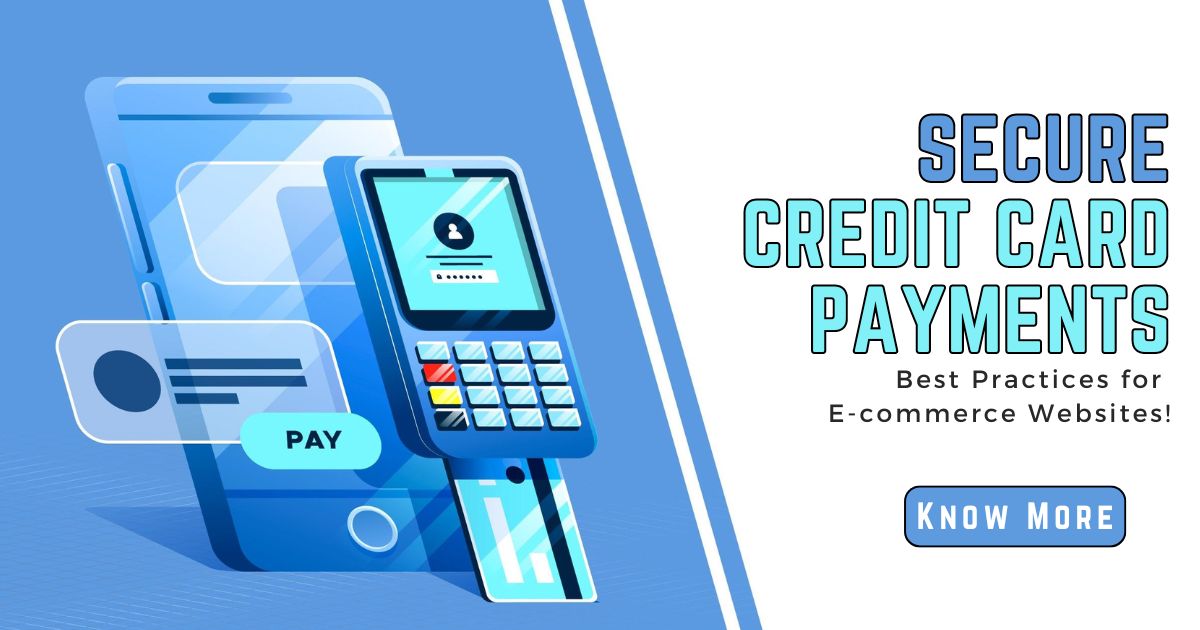
| February 28th, 2024 |
Secure Credit Card Payments — Best Practices for E-commerce Websites!
In today’s digital age, e-commerce has become the cornerstone of retail, offering convenience and accessibility to consumers worldwide. However, with the convenience of online shopping comes the responsibility of ensuring secure transactions, particularly when it comes to credit card payments. As an e-commerce website owner, safeguarding your customers’ sensitive financial information is paramount to maintaining trust and credibility. In this comprehensive guide, we’ll explore the best practices for securely accepting credit card payments on your e-commerce website.
Understanding the Risks —
Before diving into the specifics of securing credit card payments, it’s crucial to understand the risks associated with online transactions. Cybercriminals are constantly evolving their tactics to exploit vulnerabilities in payment systems, leading to potential data breaches, identity theft, and financial losses for both businesses and consumers. Common threats include:
- Payment Fraud: Fraudulent transactions conducted using stolen credit card information.
- Data Breaches: Unauthorized access to sensitive customer data stored on your website’s servers.
- Phishing Attacks: Attempts to trick users into revealing their credit card details or other personal information through deceptive means.
- Malware and Skimming: Malicious software designed to steal credit card information entered on compromised websites.
Implementing Security Measures —
To mitigate these risks and ensure the security of credit card transactions on your e-commerce website, it’s essential to implement robust security measures at every stage of the payment process. Here are some best practices to follow:
1. Use a Secure Payment Gateway:
Choose a reputable payment gateway provider that employs industry-standard encryption protocols, such as Secure Sockets Layer (SSL) or Transport Layer Security (TLS), to encrypt sensitive data transmitted between the customer’s browser and your website’s server. Additionally, opt for payment gateways that are Payment Card Industry Data Security Standard (PCI DSS) compliant, ensuring adherence to stringent security standards.
2. Tokenization:
Implement tokenization to replace sensitive credit card data with unique tokens that are meaningless to potential attackers. This ensures that even if your database is compromised, the stolen tokens are of no value to cybercriminals. Tokenization adds an extra layer of security to credit card transactions and reduces the risk of data theft.
3. Two-Factor Authentication (2FA):
Require customers to authenticate their identity using two-factor authentication methods, such as SMS verification codes or biometric authentication, before completing a transaction. This adds an extra layer of security by ensuring that only authorized users can access their accounts and initiate payments.
4. PCI Compliance:
Adhere to the Payment Card Industry Data Security Standard (PCI DSS) requirements to ensure the secure handling of credit card information. This includes implementing firewalls, regularly updating security systems, and conducting regular security audits to identify and address vulnerabilities.
5. Address Verification System (AVS):
Integrate an Address Verification System (AVS) to verify the cardholder’s billing address against the information provided during the transaction. AVS helps prevent fraudulent transactions by flagging discrepancies between the billing address and the information associated with the credit card.
6. Secure Hosting Environment:
Host your e-commerce website on a secure and reputable hosting platform that prioritizes data security and offers features such as regular security updates, malware scanning, and intrusion detection systems. Additionally, ensure that your website’s server is protected by a firewall to prevent unauthorized access.
7. Regular Security Audits:
Conduct regular security audits and vulnerability assessments to identify and address potential security weaknesses in your e-commerce website’s infrastructure. This includes testing for vulnerabilities in payment processing software, plugins, and third-party integrations.
8. Educate Customers About Security Practices:
Educate your customers about best practices for online security, such as creating strong, unique passwords, avoiding suspicious links and emails, and monitoring their credit card statements for any unauthorized transactions. Providing guidance on how to recognize and report suspicious activity can help prevent security breaches and fraud.
Conclusion —
Securing credit card payments on your e-commerce website is not just a legal requirement but also a critical aspect of maintaining customer trust and loyalty. By implementing robust security measures, such as using secure payment gateways, tokenization, and two-factor authentication, you can safeguard sensitive financial information and protect your business from the growing threat of cybercrime. Remember, investing in security today can save you from costly data breaches and reputational damage in the future.
